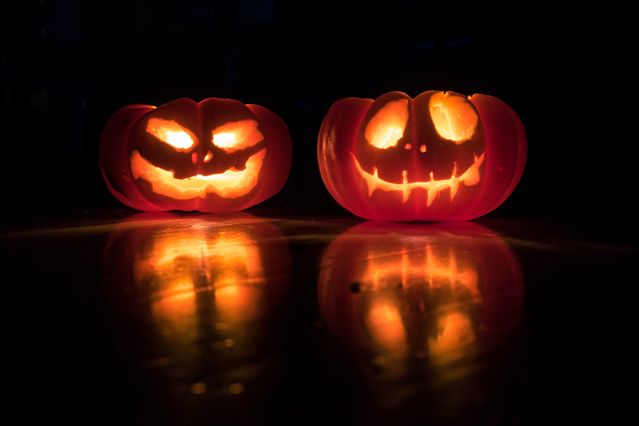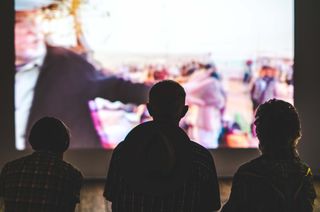Trauma
Halloween Fun or Horror?
Supporting veterans and survivors of trauma during the Halloween season.
Posted October 31, 2019

Halloween festivities can be a time of fun and community for many. Although this holiday may bring joy for some, for individuals who struggle with Post-Traumatic Stress Disorder (PTSD) and traumatic stress it may bring terror and distress. In order to better support veterans and survivors of traumatic experiences this Halloween, it is important that we are aware of how various aspects of the holiday might lead to an increase in traumatic stress symptoms.
A foundational aspect of Halloween involves fear eliciting entertainment. Whether it is through haunted houses, horror movies, terrifying costumes, or homes decorated with the intent to fright, everywhere we look we may be unexpectedly startled by what we see during the Halloween season. What is important to note here is that stimuli that might be slightly frightening to some may lead to a real experience of danger for individuals who have endured traumatic experiences.
There are real changes that occur in the brain of individuals struggling with traumatic stress and PTSD that can leave the survivor vulnerable to increased stress in fear-eliciting situations. Research notes that there are different areas of the brain involved with traumatic stress (including the hippocampus, amygdala, potential changes in cortisol levels, etc.; Bremner, 2006) but one part of the brain that is considered a main culprit in traumatic stress symptoms is the amygdala (Morey et al., 2012). The amygdala is the part of the brain that is involved with our stress and danger response systems. When an individual struggling with PTSD or traumatic stress symptoms is encountered with a stimulus that is frightening or reminds them of their traumatic experience, the amygdala may become overactive, exaggerating the brain’s stress response, and send signals to the survivor that they are currently in danger. Understandably, this can lead to immense distress. Quickly a fun Halloween experience can lead to a cascade of traumatic stress symptoms such as fear, distress, panic, flashbacks, nightmares, and more.

To gain a better understanding of what an experience for survivors might be like, I want you to picture a scenario for me. Imagine that you are watching horror movies for Halloween with your friends. As you watch the movie, a scene comes on that makes you jump out of your seat. Your brain associates the stimulus with danger and quickly reacts. You feel an intense rush of fear and even though you logically know that you are safe, it takes you a few minutes to calm down as your body and danger response system try to catch up with the reality that you are in fact safe (perhaps you even catch yourself paranoid throughout the rest of the evening trying to remind yourself that “it was only a movie”). Imagine this situation intensified such that this experience reminds you of a real experience that you survived and leaves you feeling an intense fear response that lasts for hours (making you chronically feel unsafe), elicits vivid intrusive memories, leads to the reliving a real traumatic experience (what are called flashbacks), or brings vivid recurring nightmares.
This anecdote provides a small glimpse into how fear-eliciting stimuli might lead to immense distress for survivors this Halloween. As survivors work to recover from their experiences, let us do our part in acknowledging that Halloween can be triggering for survivors of trauma who struggle with PTSD and traumatic stress. Where a few "startles" this Halloween might be fun, distress and terror is not. Here are some things that we can do to support survivors of trauma this Halloween:
1. Know what symptoms of traumatic stress and PTSD might look like. Here are a few symptoms of PTSD and traumatic stress that may surface for survivors this Halloween (APA, 2013):
- Unwanted and intrusive memories
- Flashbacks (a vivid re-experiencing of the trauma)
- Nightmares
- Emotional distress after exposure to triggers of the traumatic experience
- Physical distress and reactivity after exposure to triggers of the traumatic experience
- Hypervigilance
- Heightened startle reaction
- Difficulty sleeping
2. Limit the amount of gruesome and gory decorations and/or costumes that you use. For some, these Halloween props resemble real-life experiences and can be incredibly harmful (especially if they are stumbled upon unexpectedly).
3. Do not play practical jokes, jump out at, or touch people you do not know well or have not gotten consent from. This can be terrifying for anyone but for individuals who have survived trauma an unexpected situation like this may lead to increased traumatic stress symptoms.
4. Be a safe presence for survivors of trauma this Halloween. Remind them that they are not alone and that they are safe. Allow the survivor to tell you what is healthy for them and support them in doing those things.
And for you veterans, survivors of traumatic experiences, and those who find the Halloween season a time for increased distress and triggers, you are seen. During this season, increase your self-care and coping strategies. Allow yourself to utilize grounding techniques (using your five senses) to remind you that you are safe (e.g. listen to music, hold an ice cube, hug a teddy bear, take a warm shower, etc.) in times where traumatic stress symptoms increase. Spend time with people who help you to feel safe and do activities that increase feelings of safety and positive affect. Know your resources. You do not have to go through your experiences alone (for a 24-7 support line visit SAMHSA Support Line).
Be aware that not everyone finds Halloween fun and enjoyable. For some, it can be re-triggering, elicit panic, and be anxiety-provoking. May we all be a safe place for survivors (others or ourselves) this Halloween.
References
American Psychiatric Association: Diagnostic and Statistical Manual of Mental Disorders: Diagnostic and Statistical Manual of Mental Disorders, Fifth Edition. Arlington, VA: American Psychiatric Association, 2013.
Bremner J. D. (2006). Traumatic stress: effects on the brain. Dialogues in clinical neuroscience, 8(4), 445–461.
Morey, R. A., Gold, A. L., LaBar, K. S., Beall, S. K., Brown, V. M., Haswell, C. C., … Mid-Atlantic MIRECC Workgroup (2012). Amygdala volume changes in posttraumatic stress disorder in a large case-controlled veterans group. Archives of general psychiatry, 69(11), 1169–1178. doi:10.1001/archgenpsychiatry.2012.50
SAMHSA national helpline. (n.d.). Retrieved from https://www.samhsa.gov/find-help/national-helpline


